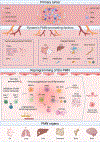Immune determinants of the pre-metastatic niche
- PMID: 36917952
- PMCID: PMC10170403
- DOI: 10.1016/j.ccell.2023.02.018
Immune determinants of the pre-metastatic niche
Abstract
Primary tumors actively and specifically prime pre-metastatic niches (PMNs), the future sites of organotropic metastasis, preparing these distant microenvironments for disseminated tumor cell arrival. While initial studies of the PMN focused on extracellular matrix alterations and stromal reprogramming, it is increasingly clear that the far-reaching effects of tumors are in great part achieved through systemic and local PMN immunosuppression. Here, we discuss recent advances in our understanding of the tumor immune microenvironment and provide a comprehensive overview of the immune determinants of the PMN's spatiotemporal evolution. Moreover, we depict the PMN immune landscape, based on functional pre-clinical studies as well as mounting clinical evidence, and the dynamic, reciprocal crosstalk with systemic changes imposed by cancer progression. Finally, we outline emerging therapeutic approaches that alter the dynamics of the interactions driving PMN formation and reverse immunosuppression programs in the PMN ensuring early anti-tumor immune responses.
Copyright © 2023 Elsevier Inc. All rights reserved.
Figures



References
Publication types
MeSH terms
Grants and funding
LinkOut - more resources
Full Text Sources
Medical

